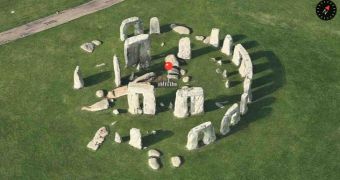If you’re strapped for cash but dying to check out Stonehenge up close, there’s now an easy way to visit the prehistoric monument right from the comfort of your couch and provided that you own one of Apple’s fancy iDevices.
Stonehenge is now accessible from Apple Maps in 3D Flyover, which means you can hover over the mysterious ring of standing stones, pinch to zoom, and rotate at will to check it out from all angles.
Don’t expect to see the pores in the monoliths, though (not that they’d let you even if you were there in person). In case you’re a stranger to Apple Maps (nobody blames you), all you need to do is launch the app, tap the search bar at the top, type in “Stonehenge,” and then select the 3D Flyover view from the row of options at the bottom (represented by a trio of skyscrapers in space view).
Go ahead and give it a try on your device, then come back to read some more about Stonehenge if you’re hungry for a late history lesson on Britain’s heritage.
Archaeologists estimate that the massive stone array was laid down within earthworks (artificial changes in land level) between 3000 BC to 2000 BC, which makes the monument over 4000 years old, at least.
A place of religious significance and pilgrimage in Neo-Druidry, Stonehenge could have been a burial ground, as the dating of cremated remains found on the site point to human bone from as early as 3000 BC. Or maybe someone died there and then a burning meteor struck them, who knows?
But the consensus (aided by Mike Parker Pearson, leader of the Stonehenge Riverside Project) remains that Stonehenge was associated with burial.
“Stonehenge was a place of burial from its beginning to its zenith in the mid third millennium B.C. The cremation burial dating to Stonehenge's sarsen stones phase is likely just one of many from this later period of the monument's use and demonstrates that it was still very much a domain of the dead,” said Pearson.
Other theories suggest that the stones possess some form of mystical power, as they are not exactly local and the people who brought them there went through a great deal of trouble to transport the heavy blocks of Bluestone form some place far away.
Some believe the stones could charge up with energy, acting like a battery. Others say that Merlin, Britain’s archmage, levitated the stones across the country and laid them in what is in Wiltshire, England today.

 14 DAY TRIAL //
14 DAY TRIAL //